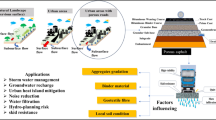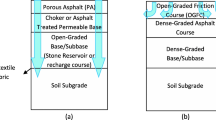Abstract
The porous pavement has always been seen as one key step of the smart city construction, but it’s not approachable to keep the balance between engineering technology and environmental protection, thus the structural design of porous pavement concrete-based water-permeable materials still cannot form an efficient theoretical foundation. Based on the principles of material science, we propose a new Contact Point Model of porous materials. Then we confirm important parameters of the model and propose a theoretical evaluation system aiming at porosity and loading capacity. Overall, we analyze its composition and structural framework to optimize its performances.
Access this chapter
Tax calculation will be finalised at checkout
Purchases are for personal use only
Similar content being viewed by others
References
Song, J., Liang, J., Yang, X., Zhang, J.: Spatial orthogonal seepage control measures for deep overburden and its feasibility. Sci. Technol. Eng. 017(020), 264–269 (2017)
Jiang, W., Yuan, D., Xiao, J., Wang, Z.: Filtration efficiency of porous pavement materials and thickness on pavement runoff. J. Jiangsu Univ. (Natural Science Edition) 38(2), 230–235 (2017)
Beecham, S., Myers, B.: Structural and design aspects of porous and permeable block pavement. J. Aust. Ceram. Soc. 43(1), 74–81 (2007)
Homel, M.A., Herbold, E.B.: Mesoscale modeling of porous materials using new methodology for fracture and frictional contact in the material point method. In: Kimberley, J., Lamberson, L., Mates, S. (eds.) Dynamic Behavior of Materials, Volume 1. CPSEMS, pp. 97–102. Springer, Cham (2018). https://doi.org/10.1007/978-3-319-62956-8_17
Chen, Z., Zhang, X., Qiu, X., Liu, Y.: A frictional contact algorithm for implicit material point method. Comput. Methods Appl. Mech. Eng. 321, 124–144 (2017)
Zhang, Y., Li, H., Abdelhady, A., Yang, J., Wang, H.: Effects of specimen shape and size on the permeability and mechanical properties of porous concrete. Constr. and Build. Mater. 266, 121074 (2021)
Author information
Authors and Affiliations
Corresponding author
Editor information
Editors and Affiliations
Rights and permissions
Copyright information
© 2022 The Author(s), under exclusive license to Springer Nature Switzerland AG
About this paper
Cite this paper
Xi, Z. (2022). Spatial Modelling and Microstructural Modulation of Porous Pavement Materials for Seepage Control in Smart Cities. In: Arai, K. (eds) Intelligent Systems and Applications. IntelliSys 2021. Lecture Notes in Networks and Systems, vol 296. Springer, Cham. https://doi.org/10.1007/978-3-030-82199-9_27
Download citation
DOI: https://doi.org/10.1007/978-3-030-82199-9_27
Published:
Publisher Name: Springer, Cham
Print ISBN: 978-3-030-82198-2
Online ISBN: 978-3-030-82199-9
eBook Packages: Intelligent Technologies and RoboticsIntelligent Technologies and Robotics (R0)




